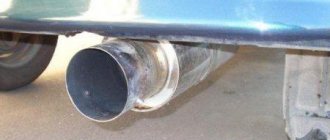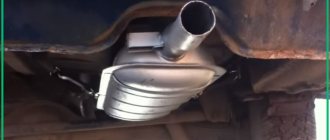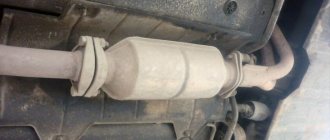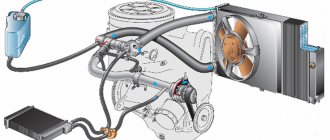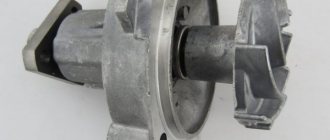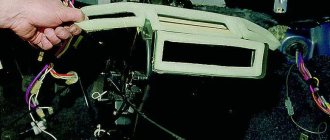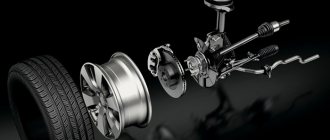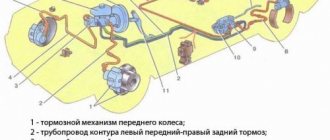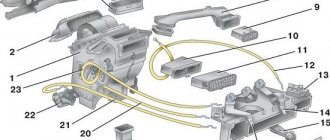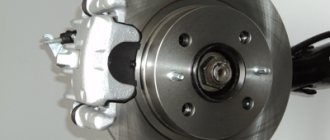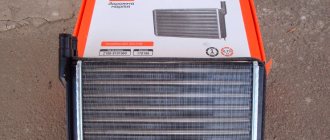Exhaust system design of VAZ 2107
Like most passenger cars, the VAZ 2107 has an exhaust system consisting of three main parts:
- a receiving pipe into which gases enter from the exhaust manifolds;
- VAZ 2107 resonator (additional muffler), where gases are directed from the exhaust pipe and where the exhaust sound is partially reduced;
- muffler, which absorbs most of the engine exhaust noise.
In addition to the above parts, the exhaust system includes:
- muffler mounting pad;
- pillow bolt;
- muffler suspension belt;
- clamp bolt and clamp securing the muffler to the resonator;
- clamp bolt and clamp securing the resonator to the exhaust pipe;
- clamp bolt and clamp securing the exhaust pipe to the body;
- nuts securing the exhaust pipe to the manifold;
- pad;
- locking plate;
The nuances of muffler repair
The muffler of “classic” VAZ cars, according to the manufacturer’s recommendations, cannot be repaired. If a malfunction occurs in any element of the exhaust tract, the part must be replaced with a new one.
In fact, motorists often prefer to repair holes burned in the muffler - the most common defect - by welding.
The occurrence of “fistulas” is indicated by a change in the sound of the engine and the appearance of smoke from under the car. To troubleshoot, place the machine on a platform and inspect the elements of the exhaust system.
If the cause is a burnt gasket, remove the muffler and replace it. When you have an assistant, you can do without removing all elements of the system. Proceed in the following order:
- Unscrew the pipe fastening to the gearbox.
- Unscrew the nuts securing the exhaust pipe to the manifold.
- Together with an assistant, pull the “pants” off the pins while simultaneously rotating the bend of the resonator pipe.
- Replace the gasket, install the pipe in place, tighten the fasteners.
A welded muffler usually lasts less than a new one. But welding is also cheaper than buying. Usually, if it is necessary to repair a muffler by welding, they turn to professionals. If you have the equipment, you can do the work yourself. For this you will need:
- welding machine;
- blanks for patches made of sheet metal 1–2 mm thick;
- a piece of pipe of the same diameter as the failed one;
- grinder with cutting disc for metal;
- metal brush;
- sandpaper;
- heat-resistant paint for metal.
To repair the muffler, follow this sequence:
- Remove the muffler from the vehicle.
- Using an external inspection, determine the location of the malfunction and the extent of the damage.
- If there is a large hole in the muffler body, evaluate the condition of the internal parts. It is possible that repairing the external surface will not bring the desired restoration of the functions of the muffler without replacing the internals. In this case, it is advisable to contact professionals or simply replace the faulty part with a new one.
- Cut out the burnt area. From the blank, make a patch larger than the damage. Weld the patch over the hole with a continuous seam.
- If there is damage at the junction of the pipe and the muffler body, cut out the defective area, replace the damaged part of the pipe, and weld the repaired pipe to the muffler with a continuous seam.
- Clean the repaired muffler from dirt and rust, paint the part with two layers of heat-resistant paint.
Video: repairing a VAZ muffler by welding
Replacing and repairing a muffler is a dirty and time-consuming job. But there is nothing complicated about it. You never know what you can do till you try.
Sooner or later, every owner of a 7 has to deal with muffler repair. To carry it out, you will need minimal knowledge of what the muffler consists of:
- Resonator (consists of a front and rear muffler and is located between the “pants” and the main one).
- The downpipe (colloquially “pants”, as it has two branches).
- Connections between these parts.
- Attaching the muffler to the bottom of the car.
What needs to be changed:
- First of all, the main muffler.
- Less often - a resonator.
- Pants are a very rare case.
Types and causes of malfunctions:
- The muffler may burn out due to high temperatures.
- The formation of corrosion due to poor fuel and condensation, which leads to metal rotting and the formation of holes in the muffler.
- Mechanical impacts, sand, gravel, salt on roads.
- Poor quality parts installed previously.
What will tell you if the muffler is faulty? First of all, the usual sound of a running engine will change, it will begin to growl. There will be a persistent smell of exhaust gases in the cabin.
A trip in such a car will not be very comfortable, problems will arise in obtaining a diagnostic card for issuing an MTPL policy, and increased attention from traffic police officers will be ensured. In addition, a faulty muffler will not provide proper ventilation to the cylinders. What mufflers are on sale for 2107
These are stamped and welded products from Takt, Togliatti and AvtoVAZagregat. It is the latter that is the original, so it is better to buy it. The cost of Takt mufflers is from 700 rubles, Tolyatti mufflers – from 850 and the original – from 1000 rubles. Prices are given in Moscow.
What mufflers are on sale for 2107. These are stamped and welded products from Takt, Togliatti and AvtoVAZagregat. It is the latter that is the original, so it is better to buy it. The cost of Takt mufflers is from 700 rubles, Tolyatti mufflers – from 850 and the original – from 1000 rubles. Prices are given in Moscow.
Differences between the exhaust systems of carburetor and injection VAZ models
Installation of an injection system on a VAZ 2107 required modernization of the exhaust system. Two additional details were added to it:
- an oxygen sensor that determines the composition of the mixture, which is embedded in the exhaust manifold;
- an exhaust gas catalyst (“catalyst”), which is installed in front of the resonator, in the central tunnel under the bottom.
In connection with the installation of the catalyst, the VAZ 2107 resonator (injector) was moved a little back.
The new exhaust system has become a little more complicated, but it allows for a reduction in the toxicity of the VAZ 2107 exhaust and ensures that the car complies with EURO-2 standards.
Advantages and disadvantages of the injection modification of the VAZ 2107
The “Seven” in injection version and with a modernized exhaust system has a number of advantages over the old “carburetor” model. They are as follows:
- thanks to the injector, the engine operates more stable in all modes;
- the specific power and torque of the injection engine are higher;
- the exhaust of a VAZ 2107 with an injection system is cleaner than smoke from a carburetor engine;
- Driving a car with an injection engine is easier, it is not so demanding on the driver’s qualifications and “forgiven” mistakes when operating the gas and clutch pedals.
But installing the injector at the same time worsened some performance characteristics:
- the clearance of the injection “seven” decreased to 7 cm, which worsened its cross-country ability;
- due to the installation of the catalyst, the “survivability” of the exhaust system has decreased;
- the high temperature of the catalyst sometimes causes grass and dry leaves to ignite when the car is stopped.
Advice : to avoid fires, it is necessary to park the injection vehicle so that there is no grass or other flammable debris under it. When stopping, it is better to turn off the engine to allow the catalyst to cool down.
How to repair a muffler with your own hands
Before you begin repairing the muffler, you need to evaluate the feasibility of these actions. Not every car owner has the skills to work with a welding machine. In addition, the muffler cannot always be properly repaired - in cases of severe burnout, it is best to immediately replace it with a new one.
Reasons for failure
Most often, mufflers on the VAZ 2106/2107 lose their functionality for the following reasons:
- mechanical damage while driving on uneven roads, impacts;
- rapid changes in temperature conditions, especially in winter, when it is cold outside, and inside the case there are very high temperatures due to exhaust;
- impurities in gasoline that come out along with exhaust gases and affect the condition of the metal surfaces of the muffler.
It is unsafe to operate a car with such damage to the muffler.
However, how urgently do you need to repair the muffler if you suddenly notice some damage to its body or black exhaust from the pipe? What are the dangers of operating a Zhiguli with a burnt out or deformed muffler?
Firstly, if there are holes in the body of any element, then the generated gases will enter the cabin. The main danger is that the exhaust is colorless and odorless and cannot be felt. In this case, the driver begins to experience headaches, nausea and dizziness. If you stay inside a car with the engine running for a long time, you can lose consciousness and even die.
Secondly, if the exhaust system does not work properly, engine power is reduced. This is especially noticeable when accelerating, starting from a standstill, or overtaking.
Thirdly, if the plug is faulty, the engine begins to consume a lot of gasoline. The carelessness of the car owner will lead to the fact that the muffler will work worse and worse, and the displacement per 100 km will increase.
How to weld a muffler
Most often, the muffler loses its tightness and therefore cannot work normally. In this case, holes can appear both on the pipes themselves and on the welds.
It is recommended to clean the weld seam and paint the work area with heat-resistant paint
Using a welding machine and metal patches can be considered the most reliable way to repair mufflers.
In order to weld a “muffler”, you need to prepare electrodes of a suitable size (it all depends on how large the hole is burned in the muffler) and a sheet of metal of the required size. After which it is recommended to carry out welding as far as possible from the edge of the holes, since the thinned edges of the metal can quickly collapse:
- Clean the torn edges of the muffler from rust and dust.
- Degrease the metal with a solvent.
- Apply a metal patch to the body and grab it in several places around the perimeter of the hole.
- After this, you can begin to apply full welds.
- After the seams have hardened, it is recommended to clean the slag with a wire brush.
It is recommended to apply welds carefully so as not to burn through the muffler body
How to change the gasket
There is a reinforced gasket between the main muffler and the resonator part. Its purpose is to prevent the resonator from heating, so it is made of heat-resistant metal.
After dismantling the muffler, it is recommended to change the gasket. This does not take much time, since the element is inserted into the muffler pipe and clamped between its parts.
How to replace hanging rubber bands
This is perhaps the simplest procedure in repairing Zhiguli mufflers. The rear part of the pipe is attached to the body with three hanging rubber bands. During the ride, some of them may get lost or seriously deformed.
To change these rubber bands, you just need to drive the car into an inspection hole or overpass, remove the old products and install new ones in their place. Some car owners change suspension rubber bands without an overpass, simply crawling under the body from the rear left side.
Exhaust system functions and parts replacement intervals
Despite its apparent simplicity, the exhaust system performs several important functions:
- removal of fuel combustion products;
- reduction of noise level from the exhaust;
- maintaining air balance in intake and exhaust systems;
- ensuring ventilation and cleaning of cylinders;
- reduction of CO content (in the presence of a catalyst).
Exposure to high temperatures, moisture, fuel and oil combustion products leads to through corrosion of exhaust system parts. This is aggravated by the external influence of gravel, sand and salt solutions that are used to treat roads in winter. Therefore, parts of the system have to be changed.
The frequency of replacement depends on the following factors:
- car use activity;
- frequency of machine operation in bad weather (rain, snow);
- fuel quality;
- quality of exhaust system parts.
Tip : You can extend the life of the exhaust system by treating the installed parts with graphite lubricant. All that remains is to start the engine and warm up the exhaust system. The parts will heat up and the lubricant will burn out, leaving a thin layer of film that reliably protects against corrosion. Another option is to purchase an aluminum, rather than steel, resonator, muffler and “pants” of the VAZ 2107. They will cost more, but aluminum is less susceptible to corrosion and will last much longer.
Replacing the muffler VAZ 2107
The VAZ 2107 muffler (injector and carburetor) is connected to the resonator with a clamp, which is located in front of the rear axle. Before removing the clamp, it should be tapped with a hammer to make it easier to unscrew the threaded connection and uncouple the pipes.
To change the muffler, you need to do the following:
- loosen the clamp bolt and remove (move) the clamp;
- pull the flared muffler pipe off the resonator (if that doesn’t work, knock it down with a hammer and chisel);
- remove the muffler from the cushion and mounting straps;
- install a new muffler on the VAZ 2107;
- tighten the clamp.
Replacing the VAZ 2107 resonator
The VAZ 2107 resonator does not have fastening parts to the car body, so it is necessary to hold it when replacing it. Otherwise the exhaust pipe will be bent.
The replacement work consists of the following steps:
- tap clamps and pipe connections with a hammer;
- loosen the bolts of the clamps and move the clamps fastening to the “pants” and the muffler;
- disconnect the resonator from the muffler by undocking the pipes;
- disconnect the resonator from the receiving pipe (“pants”);
- install the new resonator in the correct position;
- connect the parts and tighten the fastening clamps.
Note: the resonator tank must be parallel to the ground, otherwise the part will knock on the bottom of the car and cling to uneven road surfaces.
Replacing the exhaust pipe (“pants”) of a VAZ 2107
When replacing the exhaust pipe, be sure to replace the gasket between it and the exhaust manifold. It is also better to change the nuts securing the “pants” to the manifold. The procedure is as follows:
- loosen the clamp and disconnect the pants from the resonator;
- unscrew the four nuts securing the exhaust pipe to the manifold;
Important: unscrew the nuts carefully so as not to twist the fastening studs. Otherwise, you will have to drill out and replace the studs.
- remove the “pants” (exhaust pipe) and gasket;
- install a new gasket;
- install a new exhaust pipe;
- connect the exhaust pipe to the resonator, tighten the fastening clamp;
- tighten the nuts securing the “pants” to the manifold.
If, after installing a new exhaust pipe, the exhaust system sags or hits the bottom, the following options are possible:
- the resonator or exhaust pipe is fixed at the wrong angles;
- engine mounts sagged.
In the first case, it is enough to loosen the clamps and install the parts correctly. In the second case, the engine mounts will have to be replaced.
The nuances of muffler repair
The muffler of “classic” VAZ cars, according to the manufacturer’s recommendations, cannot be repaired.
If a malfunction occurs in any element of the exhaust tract, the part must be replaced with a new one.
In fact, motorists often prefer to repair holes burned in the muffler - the most common defect - by welding.
The occurrence of “fistulas” is indicated by a change in the sound of the engine and the appearance of smoke from under the car. To troubleshoot, place the machine on a platform and inspect the elements of the exhaust system.
If the cause is a burnt gasket, remove the muffler and replace it. When you have an assistant, you can do without removing all elements of the system. Proceed in the following order:
- Unscrew the pipe fastening to the gearbox.
- Unscrew the nuts securing the exhaust pipe to the manifold.
- Together with an assistant, pull the “pants” off the pins while simultaneously rotating the bend of the resonator pipe.
- Replace the gasket, install the pipe in place, tighten the fasteners.
Replacing a burnt muffler gasket eliminates extraneous sounds from the engine
A welded muffler usually lasts less than a new one.
But welding is also cheaper than buying. Usually, if it is necessary to repair a muffler by welding, they turn to professionals. If you have the equipment, you can do the work yourself. For this you will need:
- welding machine;
- blanks for patches made of sheet metal 1–2 mm thick;
- a piece of pipe of the same diameter as the failed one;
- grinder with cutting disc for metal;
- metal brush;
- sandpaper;
- heat-resistant paint for metal.
To repair the muffler, follow this sequence:
- Remove the muffler from the vehicle.
- Using an external inspection, determine the location of the malfunction and the extent of the damage.
- If there is a large hole in the muffler body, evaluate the condition of the internal parts. It is possible that repairing the external surface will not bring the desired restoration of the functions of the muffler without replacing the internals. In this case, it is advisable to contact professionals or simply replace the faulty part with a new one.
- Cut out the burnt area. From the blank, make a patch larger than the damage. Weld the patch over the hole with a continuous seam.
- If there is damage at the junction of the pipe and the muffler body, cut out the defective area, replace the damaged part of the pipe, and weld the repaired pipe to the muffler with a continuous seam.
- Clean the repaired muffler from dirt and rust, paint the part with two layers of heat-resistant paint.
Photo gallery: muffler welding
If there is damage at the joints of the pipe and the muffler body, weld the repaired pipe to the muffler with a continuous seam. From the workpiece, cut a patch larger than the damage. Weld the damaged pipe with a continuous seam.
Video: repairing a VAZ muffler by welding
Replacing and repairing a muffler is a dirty and time-consuming job. But there is nothing complicated about it. You never know what you can do till you try.
The exhaust system of a car performs two useful functions at once: releasing exhaust gases, partially cleaning them, and also reducing the noise level from the operation of the internal combustion engine.
Today we will talk about such an important part as the resonator. Let's try to figure out why and how the replacement is performed.
The resonator of any car is an additional muffler that reduces the noise level of the engine. In addition to the main “can,” the resonator, or as it is also called, receiving pipe can be equipped with an additional one.
It is worth noting that the resonator operates at high temperatures. Exhaust gases at high temperatures are supplied to it, which gradually cause the heat-resistant metal to wear out. In addition, the resonator on the VAZ 2107 is too close to the road surface, which causes mechanical damage to the exhaust pipe.
Ultimately, holes appear on the surface of the resonator, which disrupt its operation. Exhaust gases escape through these defects, creating an unpleasant sound of the engine, which is not only unpleasant to others, but will certainly not leave traffic inspectors indifferent. That is why a damaged resonator must be replaced immediately.
Exhaust System Mounting Parts
The clamps and suspension elements of the exhaust system are exposed to moisture and salt during machine operation. In addition to corrosion, metal “fatigue” accumulates in clamps. The clamps begin to loosely hold the connection, as a result of which exhaust gases begin to break out, creating noise. Old suspension cushions may break off, which can damage exhaust system parts. Therefore, it is advisable to change the mounting parts; whenever large parts are replaced, the mounting elements on which they are attached should also be changed. This will avoid unnecessary problems and expenses.
Repair of the exhaust system of VAZ 2107
Repair of the exhaust system on the VAZ 2107 is based on the replacement of component parts. Moreover, devices such as pants, a resonator or a muffler change. The reasons for the need for their repair are corrosion or burning of the metal. Internal parts corrode when exposed to moisture, which causes their destruction.
Moreover, there are two types of damage: both the internal components, which are presented in the form of meshes, and the outer walls of the component parts are damaged. It is not difficult to detect a breakdown and the need for repair. As soon as, after starting the engine, extraneous noise is detected coming from under the bottom, it is time to diagnose the system and identify the cause of the breakdown.
If the breakdown is due to a malfunction of internal parts, then the part must be replaced. If the cause of the noise is the appearance of holes in the body of the device - the resonator, muffler or pants, then you can try to eliminate them using a welding machine.
The VAZ 2107 resonator is replaced if it malfunctions. When replacing this device, it is important to consider the following recommendations:
- Replacement must be carried out only after the car has cooled down, since the exhaust pipe gets very hot when the engine is running.
- When removing the resonator, it is important to take into account such a factor as maintaining the device. After all, this part is not fixed, but is held in place by connecting to the pants and the muffler
If the muffler on a VAZ 2107 is faulty, then it also needs to be replaced. The replacement process is not difficult, however, this will require an inspection hole or overpass, from which the corresponding actions are carried out.
If the connecting pipes of the exhaust system elements in question are damaged, they can also be repaired, extending the service life to several thousand km. To eliminate such a breakdown, you will need to arm yourself with a special high-temperature sealant, as well as auxiliary tools and parts - metal scissors, soft metal for sealing, a metal brush to remove dirt, sandpaper and degreaser.
The repair process consists of performing the following tasks:
- Clean the rusted area.
- Cut a clamp that can be used to block the through holes.
- The rusted area must be degreased and then a sealant must be applied.
- Wrap the area with a piece of soft metal, and then place a tightening clamp on top.
- The most important thing when carrying out such repairs is the quality of sealing.
After the sealant has hardened, you can start the engine and check the quality of the repairs. You can make sure that everything was done correctly by such signs as the absence of extraneous noise and smoke coming out of the repaired area.
If the catalyst is faulty, it is usually replaced by inserting a pipe of the appropriate diameter. It is irrational to buy a new catalyst, since it is quite expensive and lasts no more than 100,000 km.
Exhaust system tuning
What is the basis for tuning the VAZ 2107 exhaust system? The system can be improved completely or selectively, depending on the task at hand. For example, instead of a standard exhaust pipe, you can install a StinGer spider, which is equipped with a double pipe made of stainless material. Replacing the exhaust manifold will increase the engine power, and it has even been calculated that this figure increases to 9 horses.
Instead of the standard VAZ 2107 muffler, you can install a direct-flow muffler, which you can even make yourself. A direct-flow muffler has one drawback - it will increase the noise of the engine, but at the same time the power will increase.
Tuning the VAZ 2107 exhaust system can be divided into 2 categories - cosmetic and technical. Cosmetic tuning involves replacing standard rusting elements with silumin ones, which have a beautiful appearance and also last 2-3 times longer than regular ones. If you plan to tune the exhaust system, then it is recommended to start with the pants, since this particular part is the main one in the device in question.
What to do if the muffler on a Zhiguli is knocking
You immediately need to figure out which part the muffler pipe is knocking on. On VAZ classic cars there can only be two options:
- o gas tank;
- about the body.
In each case, the order of work will be different. If the muffler loudly hits the gas tank while driving, this indicates that the connecting clamp between the muffler and the resonator was installed incorrectly, which is why the “muffler” moves to the side. That is, you need to drive the car into the inspection hole again and make sure that all the muffler connections are correct.
If the pipe knocks on the body while driving, the easiest way to prevent this sound is by replacing the rubber bands. During operation, they can stretch out or even fly off, causing the muffler to move back and forth. If all three rubber bands are in place, then it is recommended to line the junction of the muffler and the body with rubber. This will ensure that there is no knocking while driving and will make the muffler more stable.
Design and operation of the exhaust tract
The exhaust system includes 3 main elements (starting from the power unit):
- double exhaust pipe, in driver's jargon - “pants”;
- middle section equipped with one or two resonator tanks;
- the last section is the main muffler.
According to the factory operating instructions for the car, the exhaust manifold is a part of the engine and does not belong to the flue gas exhaust system.
The number of resonators in the middle part of the tract depends on the type of engine installed on the VAZ 2107. If the car was equipped with a 2105 engine with a working volume of 1.3 liters, 1 tank was provided per section (modification of VAZ 21072). Cars with 1.5 and 1.6 liter power units (VAZ 2107-21074) were equipped with pipes for 2 resonators.
On a VAZ 2107 with a 2105 engine, it is not advisable to install a section with 2 tanks - this reduces the power of the power unit. Dreaming of quiet operation of the 1.3 liter engine, I personally tried to change the 1-tank resonator to a 2-tank one. I didn’t notice a decrease in the exhaust sound, but I clearly felt a drop in traction under load.
The entire tract is attached at 5 points:
- the flange of the “pants” is screwed to the outlet manifold with 4 bronze M8 nuts;
- the end of the exhaust pipe is attached to the bracket on the gearbox;
- the flat muffler tank is hooked by 2 rubber hangers;
- The muffler outlet pipe is fixed with a rubber cushion screwed to a metal body bracket.
The principle of operation of the tract is quite simple: the gases pushed out by the pistons pass through the manifold and “pants”, then enter the resonator section. There, preliminary suppression of sound vibrations and a decrease in temperature occur, after which the combustion products enter the main muffler. The latter reduces the noise level as much as possible and releases gases to the outside. Heat transfer and cooling of the smoke occurs along the entire length of the exhaust elements.
On “sevens” with an injector, the exhaust design is supplemented with a catalytic converter and oxygen sensors. The element is located between the receiving pipe and the second section, the connection method is flange. The catalyst cleans flue gases from toxic compounds (nitrogen oxide and carbon), and lambda probes inform the electronic control unit about the completeness of fuel combustion based on the free oxygen content.
Purpose of the exhaust system
Before combustion in the engine cylinders, gasoline is mixed with air and supplied through the intake manifold into the combustion chamber. There, the mixture is compressed eight times by the pistons and ignited by a spark from the spark plug. As a result of the process, 3 components are formed:
- heat and mechanical energy that rotates the crankshaft;
- gasoline combustion products - carbon dioxide and carbon monoxide, nitrogen oxide and water vapor;
- combustion under high pressure generates sound vibrations - the same exhaust sound.
Since the efficiency of internal combustion engines does not exceed 45%, about half of the released energy is converted into heat. One part of the heat is removed by the engine cooling system, the second is carried out by the exhaust gases through the exhaust tract.
The smoke at the exit from the duct is cooled to a safe temperature, you can calmly raise your hand - it won’t burn you
The VAZ 2107 exhaust system performs several important functions:
- Emission of combustion products from the chambers and ventilation of the cylinders after the next combustion cycle.
- Reducing the amplitude of sound vibrations, that is, reducing the noise level of a running motor.
- Removal and dissipation of part of the released heat in the atmosphere.
On “sevens” with an injection power system, the exhaust tract solves another important task - it cleans the exhaust from toxic gases CO and NO by afterburning in a catalytic converter.
